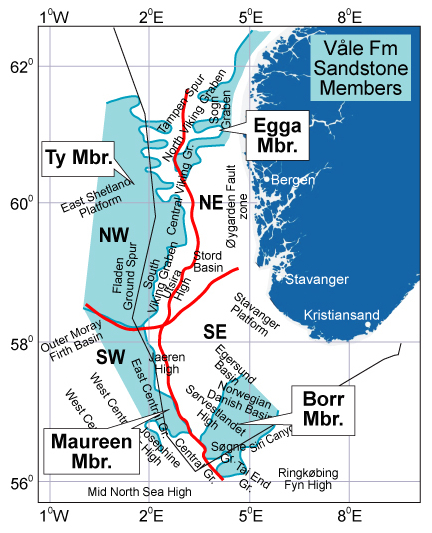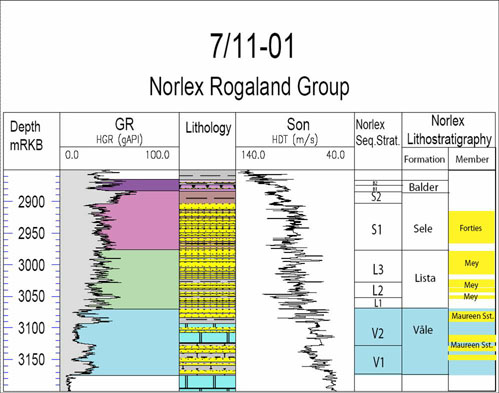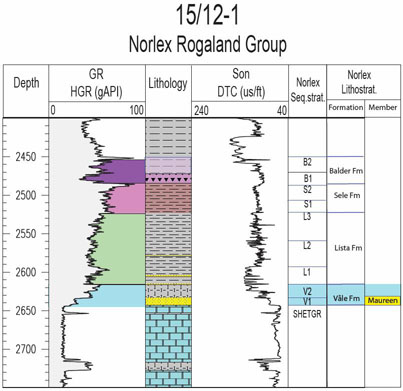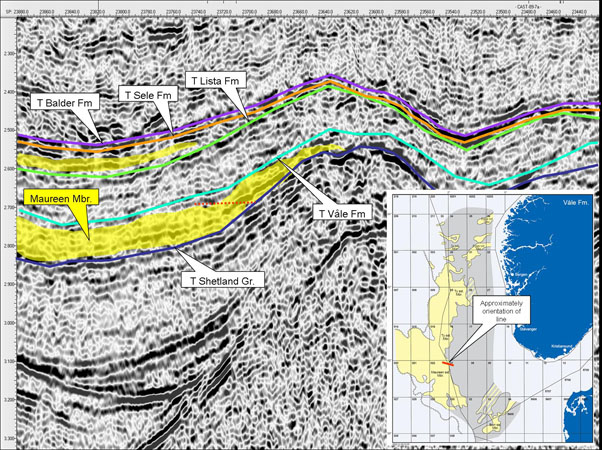Maureen Member
updated to follow: Stratigraphic Guide to the Rogaland Group, Norwegian North Sea. Harald Brunstad, Felix M. Gradstein, Jan Erik Lie, Øyvind Hammer, Dirk Munsterman, Gabi Ogg, and Michelle Hollerbach. Newsletter on Stratigraphy, vol 46/2 pp137-286, 2013.
Rogaland Group, Våle Formation
Unit definition
The Maureen Member is attributed to the intra Våle Formation sandstones in
subarea SW in
Fig. 1, and
belongs to the stratigraphically oldest sandstones of the Rogaland Group in this
area.
 Fig 1: Location map of the Members of the Våle Formation.
Fig 1: Location map of the Members of the Våle Formation. |
Name
The Maureen Formation (now Ty Member) was defined by Deegan and Scull (1977) and attributed to a mixed
lithology of Danian to early Selandian age, i.e. time equivalent to the Våle Formation. The same
definition was
used by Hardt et al. (1989) in Tonstad et al. (1989) for the correlative lithologies stretching into the
Norwegian part of the Central Graben, onlapping basin margins to the east.
Derivatio nominis
In this study we make a lithostratigraphic subdivision of the interval regarding the Norwegian part of the
Central Graben. We attribute the name Maureen Member to sandstones internally in the Våle Formation of the
Norwegian Central Graben, corresponding to the sandstone part of the Maureen Formation on the UK side.
Type well (new, this study)
We define Norwegian well 7/11-1 as the type well for the Maureen Member (earlier reference well). The
stratigraphy of this well is redefined from the reference well for the Maureen Formation to the type well for
the Maureen Member in the Norwegian sector:
Well 7/11-1 (Fig. 49). Depth 3173 to 3069 m,
Coordinates N 57°04'15.60'', E 02°26'24.40''. No cores.

Fig. 49. Well 7/11-1 composite log Rogaland Group. Stratigraphic position of the Maureen Member is outlined
in stratigraphic column to the right.
|
Reference wells (new, this study)
Norwegian well 15/12-1, (Fig. 50) from 2616 to
2644m
Coordinates N 58°10'32.60", E 1°44'23.10".
Core example 8642-9698'.

Fig 50. Well 15/12-1 composite log Rogaland Group. Stratigraphic position of the Maureen Member is outlined
in the stratigraphic column to the right.
|
Composition
The Maureen Member shows much the same characteristics as the Ty sandstones, but displays
more frequent
interbeds of reworked chalk. The sandstones are generally fine grained. Thick units of clean, poorly sorted
sandstones are present locally, but more commonly the sandstones occur as several series of thinner units,
often with chalky matrix. Thin beds of muddy, matrix-supported sandstone with mudstone and limestone fragments
are locally present in the upper part of the formation (Knox & Holloway, 1992).
Wireline log characterization
From wireline logs, sandstones of the Maureen Member are seen to have a blocky to serrated
appearance.
Carbonate interbeds are characterised by low gamma-ray readings and high velocity beds. The thickness
of sandstones in the Maureen V2 Member (upper member, see text below) is generally larger and
chalk interbeds are
less frequent than in the Maureen V1 Member. Sonic logs indicate that the upper sandstones in general are less
cemented than the lower Maureen V1 Member.
Upper boundary
The upper boundary is characterised by a downwards transition from higher gamma-ray
readings and lower
velocity in the Våle or Lista Formation
to lower gamma-ray
readings and higher velocity in the Maureen Member.
Lower boundary
The Maureen Member rests on the Våle Formation or directly on the Shetland Group. There is a distinct upwards
change from low gamma-ray readings and high velocities in the calcareous sediments of the Shetland
Group or
the Våle Formation to higher and more irregular gamma-ray readings and decreasing velocities in the Maureen
Member.
Thickness
In the Norwegian Central Graben area, the Maureen Member is usually present as series of m-scale
to a few tens
of meters. In the type well 7/11-1 the thickness is 104 m, and in reference well 15/12-1 it is 28 m.
Thickness
of corresponding sandstone beds on UK side of the Graben may be substantially larger, with up to 400
m of
mainly sandstones in the Which Ground Graben (Hardt et al, 1989).
Seismic characterization
The Maureen Member generally consists of laterally stacked seismic bodies of lenticular to mounded character
(Fig. 51). They are interbedded with and interrupted by interlayers of reworked chalk. This gives variable
continuity and character. Since amplitudes of internal seismic reflectors also vary much, the Maureen Member
can be difficult to map seismically.

Fig. 51. Seismic section through the Northern Central Graben with sandstones of the Maureen Member pinching
out in the Everest Field (Armada Complex).
|
Age
The age of the Maureen Member is Danian to early Selandian (Morton et al., 1993, Neal, 1996 and Mudge & Bujak,
1996).
Biostratigraphy
The top occurrence of S. magnificus is characteristic for the Maureen Member in the lower part of the
Våle
Formation, whereas the dinocyst I. ?viborgense (bioevent Iv.) is typical to the upper parts. Top Iv.
normally
falls near the top of the Våle Formation, or slightly into the Lista Formation (Mudge and Bujak, 1996).
Correlation and subdivision
It is possible to subdivide the Member into two units: MaureenV1 and MaureenV2 Sub-members. The
MaureenV1
Sub-member is found in the lower Våle interval, the MaureenV2 Sub-member in the upper. The two can be
distinguished biostratigraphically by the S. beccariformis acme, which separates Upper and Lower Våle
Formation.
Geographic distribution
The Maureen Member is an extensive sandstone interval in the Våle Formation in the
Norwegian Central Graben.
The member is limited southeastwards by the Jæren High and to the north by the Member Separation line from
Fladen Ground Sput to the southern end of the Utsra High (Figs. 12 and 13). These westerly sourced sandstones
have their eastern extension in the western part of the Norwegian sector (Central Trough). The member extends
into the southeastern part of the Breiflabb Basin, and the westernmost part of Quadrant 7 and northwestern
part of quadrant 1 (Fig. 48).
Depositional environment
In the Norwegian sector the Maureen Member was deposited in the same way as the Ty
Member, i.e. from
gravitational flows along the terminal edge of a deep marine slope to basin fan system. The sandstones have
the East Shetland Platform and the mid North Sea High as their provenance. More frequently occurring interbeds
of reworked chalk in the Maureen Member relative to the Ty Member can be explained by a more extensively
exposed provenance area of chalky lithologies in the Moray Firth area than on the East Shetland Platform. Post
depositional cementing of sandstones may be explained by carbonate leaching from reworked chalk and Våle
marls, with subsequent precipitation in the Maureen sandstones.


 Fig 1: Location map of the Members of the Våle Formation.
Fig 1: Location map of the Members of the Våle Formation.

